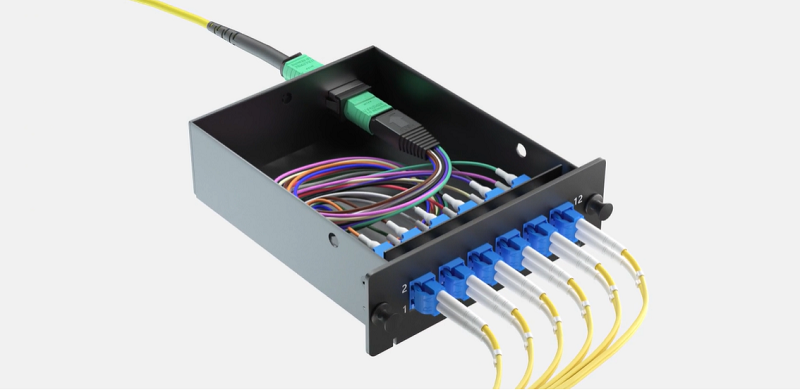The Fiber-Life community has provided a lot of answers to questions about MTP/MPO fiber networks. This article will summarize these questions and their solutions to help you gain a more comprehensive understanding of MTP/MPO fiber networks.
What Are MTP/MPO Cables?
MTP/MPO cables, composed of MTP/MPO connectors and optical fibers, are designed for high-density cabling in data centers, with the advantages of increasing network capacity, saving space, and simplifying cable management. There are a variety of MTP/MPO cables in terms of cable function, polarity, fiber count, fiber mode, and jacket rating.
Learn more: What Is MTP®/MPO Cables? How To Use MTP®/MPO Cables?
The Development of MTP Cables
With better performance and lower network infrastructure costs, MTP cables replace cables terminated with SC and LC connectors in high-density data centers and enterprise networks. From the increase in the number of fibers to the release of the lower insertion loss version of MTP Elite, MTP cables are constantly evolving. In the future, MTP cables will continue to advance to overcome challenges in connector gender and polarity management.
What Are the Differences between MTP® and MPO Cables?
The key differences between MTP® and MPO cables come in their connectors. As for their connectors’ mechanical design, MTP® and MPO cables are different in terms of pin clamp, floating ferrule, and housing removability. Moreover, these two cables’ optical performances, such as insertion loss and reliability, also differ.
MTP®/MPO Cabling in Spine-Leaf Architecture
MTP/MPO cabling solves the cable installation and management challenges of spine-leaf architecture and reduces time and labor costs. In particular, MTP/MPO optic fiber cables support fewer connections and feature lower insertion loss, which increases redundant Ethernet cross connections and contributes to the deployment of spine-leaf architecture.
How to Distinguish the Quality of MTP/MPO Cables?
There are five main factors that help distinguish high-quality MTP/MPO cables: fiber core, MTP/MPO connectors, insertion loss, flame retardant grade, and fiber cable test. Comparing the specifications of MTP and MPO cables in these aspects can effectively determine their quality and performance.
How to Test MTP/MPO Cables?
In order to test the specific performance of MTP/MPO cables, inspection and cleaning are the first steps, followed by testing for fiber continuity, power of fiber optic equipment and cables, fiber attenuation, and connector insertion loss using a visual fault locator, optical light source and optical power meter, and OTDR.
What Are MTP/MPO Conversion Cables and Their Applications?
MTP/MPO conversion cables have the same form as MTP/MPO breakout cables but are terminated with MTP/MPO connectors on both ends, especially fitting for high-density cabling. MTP/MPO conversion cables are used for network migration, such as 10G-40G, 40G-40G, 40G-100G, and 40G-120G direct connections.
What Is an MTP® Connector?
MTP® connector is one type of MPO connectors but enhances its design and improves optical and mechanical performance compared to generic MPO connectors. MTP® means Multi-fiber Termination Push-on, which is a better-designed connector owned by USConec.
How to Clean MTP/MPO Connectors?
There are two MTP/MPO connector cleaning methods, namely dry cleaning with cassette cleaner and one-push cleaner and wet cleaning using cleaning wipes or foam swabs. When cleaning MTP/MPO connectors, the most important note is to inspect, clean, and inspect again.
What Are Modular MTP®/MPO Cassettes?
Modular MTP®/MPO cassettes are LGX format enclosed units that contain 8, 12, or 24-fiber factory terminated fan-outs inside. MTP/MPO to LC/SC/ST fiber cassette enables plug-and-play fiber connectivity, which simplifies installation and reduces the cost of deployment and maintenance.

What is Polarity in MTP/MPO Cabling System?
Polarity defines the direction in which the optical signal travels in the fiber. Proper polarity means the transmitting end (TX) and the receiving end (RX) of the optical link are correctly matched, ensuring the right signal transmission direction.
For more information: Learn About MTP MPO Cabling Systems To 10 Tips
Base-8 and Base-12 MTP/MPO Cabling System: How to Choose?
Base-8 MTP/MPO cabling and Base-12 MTP/MPO cabling make use of different fiber optical links. And they are different in terms of fiber utilization and availability for future larger networks.
How to Apply Base-24 MTP/MPO Cabling for 40G/100G?
Base-24 MTP/MPO fiber optic cabling system is based on 24-fiber MTP fiber optic connectors, and the links are built in increments of 24 fibers. There are four typical Based-24 MTP/MPO cabling solutions, which can be applied for 40G/100G networks.










